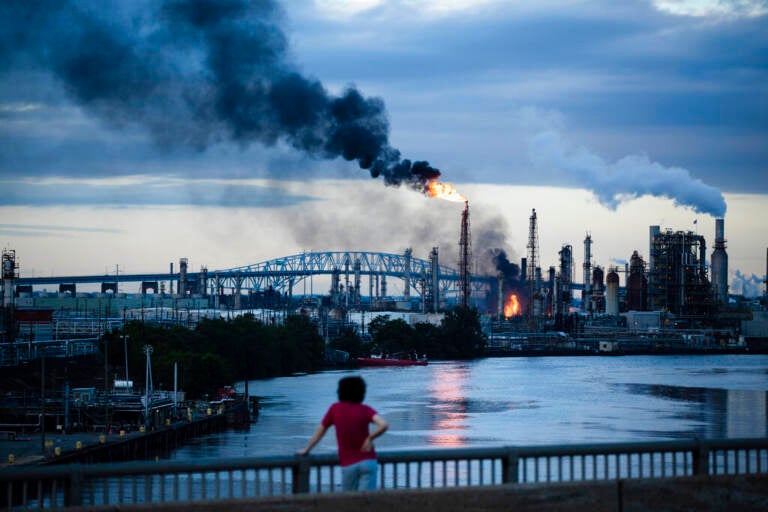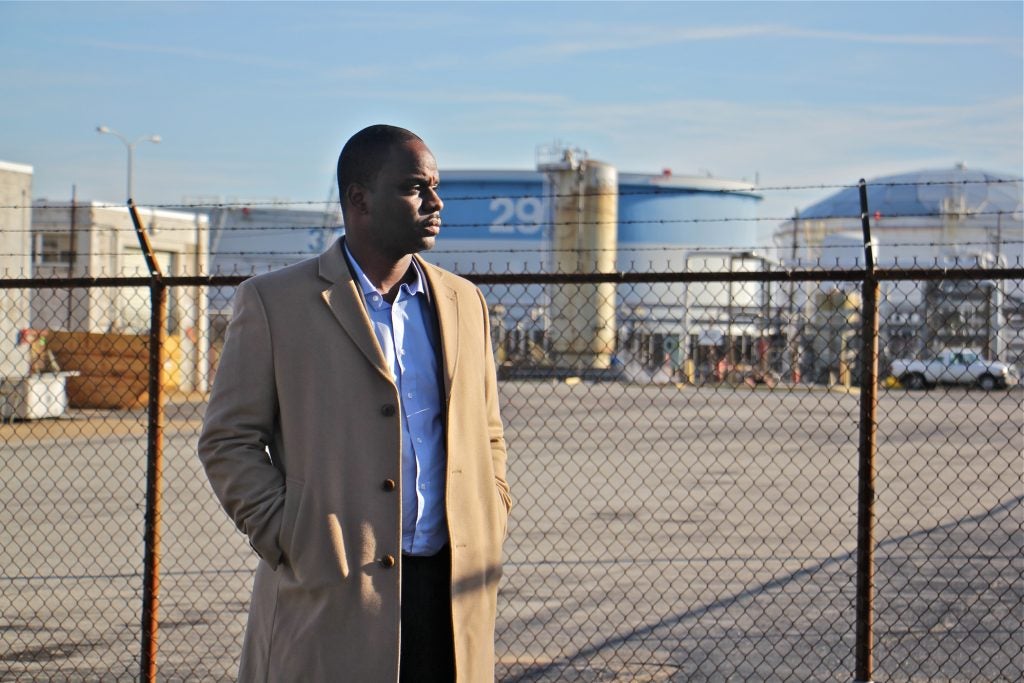‘This is how I’m gonna die’: Former employees remember the PES refinery explosion, 5 years later
A series of explosions in 2019 shuttered the largest oil refinery on the East Coast. Here’s a look back at that day.
Listen 4:53
This photo from June 21, 2019 shows flames and smoke emerging from the Philadelphia Energy Solutions Refining Complex in Philadelphia. The blaze and a series of explosions shook homes and caused extensive damage at the refinery, the largest on the East Coast. The company shuttered the 150-year-old site and laid off workers. (AP Photo/Matt Rourke, File)
Have a question about Philly’s neighborhoods or the systems that shape them? PlanPhilly reporters want to hear from you! Ask us a question or send us a story idea you think we should cover.
Charles Hook was scheduled to work an early morning shift at the Philadelphia Energy Solutions refinery June 21, 2019.
But a delayed shipment meant he stayed home in Audubon, New Jersey.
“I went back to sleep,” he said. “4:21 [a.m.], the explosion happened.”
Hook’s wife was awake, getting ready for work, when she heard the “big thud.” She saw on the news a video of Hook’s workplace engulfed in flames.
“She runs upstairs. ‘Chuck, you have a problem,’” Hook remembers her saying. “‘The refinery blew up.’”

It’s been five years since the explosion and massive fire at the Philadelphia Energy Solutions refinery in South Philadelphia that lit up the early morning skies and ultimately shuttered the more than century-old facility.
Although nobody knew the cause at the time, an investigation by the Chemical Safety Board later found that a leak from a corroded pipe caused a series of explosions that released thousands of pounds of the dangerous chemical hydrofluoric acid resulting in an estimated $750 million worth of damage.
Days later, the company that ran the refinery announced the complex would shut down for good.
“Ninety days later, I was laid off,” Hook said.
What happened that day
Bilal Motley was finishing his shift as a foreman in the refinery’s wastewater treatment department when reports of a fire in Unit 433 came over his radio.
“I was like, ‘Oh no, not this,’” he remembered.

Motley said Unit 433 was considered the “bogeyman,” because it contained a potentially deadly chemical: hydrofluoric acid (HF).
Swallowing just a small amount of HF or getting small splashes on the skin can be fatal, according to the Centers for Disease Control. In the gaseous state, the CDC says, low levels of HF can irritate the eyes, nose and respiratory tract. Breathing it at high levels “can cause death from an irregular heartbeat or fluid buildup in the lungs.”
A worst-case-scenario incident at PES could have meant the release of 143,262 pounds of HF over 10 minutes, according to a risk management plan the company filed with the EPA. The toxic cloud could have traveled more than 7 miles and potentially impacted over 1,000,000 people, including those in schools, homes, hospitals, prisons, playgrounds, parks and a wildlife sanctuary.
So Motley and his crew were right to be fearful.
“The fire was just getting bigger and bigger,” Motley said. “It was just terrifying. It started to grow even more, and you saw tanks starting to fly around.”
At one point, a piece of a vessel that weighed as much as a bus flew across the Schuylkill River, but luckily landed far enough away from any residences or businesses.
By 5:30 a.m., WHYY reporter Robby Brod was on the scene. Unaware of the potential dangers, he described what he saw to listeners.
“There are about two or three fires coming out of the refinery,” he said. “There’s smoke pouring into the sky all around Southwest Philly. There is a distinct odor.”
Motley and the other foremen were trained firefighters, so they sprung into action, setting up a perimeter and opening up fire hydrants, he remembers. Meanwhile, Motley was getting calls from family members and struggling to hear his coworkers over the radio.
“It was just chaos,” he said.
Specialized industrial firefighters arrived to help the Philadelphia Fire Department and refinery workers.
The Philadelphia Fire Department and Philadelphia Office of Emergency Management briefly issued a shelter-in-place advisory for a small area of nearby residents.
At the time, many nearby residents were unaware how dangerous the explosion was, and how lucky they were that the deadly HF was contained by the quick thinking of one of the control room employees, who diverted more than 43,000 gallons of the chemical from its container near the fire to a safe location.
Michelle Walker, who was also working inside the refinery’s control room, remembers seeing flames on the unit surveillance monitors before the screens went black.
“The big explosion … felt like a train was going by,” she said. “The whole floor rumbled … All the ceiling tiles flew up and came back down again, and dust was everywhere.”

The most frightening moment was when the emergency radio channel fell silent.
“For what felt like an hour but probably was only a minute or less, there was just silence,” she said. “I looked over at my coworker, and he’s a bigger dude, and he was just crying. He said, ‘They’re all dead.’”
Then finally, a voice came through on the radio.
“The whole room started breathing again,” Walker said.
In the end, 5,000 pounds of HF leaked from the unit, with most of the chemical being released to the atmosphere. The incident also released more than 600,000 pounds of hydrocarbons, most of which burned.
The origin of the explosion was the rupture of a faulty, old pipe “elbow,” which allowed propane and HF to leak and form a ground-hugging vapor cloud that quickly ignited.
It took more than 24 hours for the fire to be fully extinguished.
“I really thought, ‘Alright, this is how I’m gonna die,’” Motley said. “This is what they trained us for … I don’t think we’re going to get through this. But somehow we did.”
No employees were killed that day. Only five had minor injuries.
Within days, Philadelphia Energy Solutions announced it would close the refinery. Around 1,000 workers — including Hook, Walker and Motley — were eventually laid off.
As a result of the explosion and near miss of a massive release of HF, the Chemical Safety Board urged the EPA to step up its enforcement of facilities that use the deadly chemical under the Clean Air Act.
In August 2023, the EPA did announce an initiative that would prioritize inspections of non-compliant facilities that use hazardous chemicals, including HF. Some advocates continue to call for refineries to phase out the chemical, which is integral to the production of high-octane gasoline.
Dozens of refineries nationwide, including Monroe Energy in Trainor, Delaware County, still use HF.
What’s the future of the site?
The jungle of pipes, tanks and buildings where the three once worked has been largely leveled, and a warehousing and logistics campus has begun to rise in its place.
This spring, Hilco Redevelopment Partners (HRP), the company that bought the site after PES declared bankruptcy, began building a 300,000-square-foot warehouse on the southeastern portion of the site. It’s the first of over a dozen planned for the logistics portion of The Bellwether District, which developers say will also include a life sciences campus and could mean jobs for more than 19,000 people.
It’s a massive transformation for the site, which was originally built as an oil refinery in the mid-1800s. With the refinery’s closure, the city’s single largest source of planet-warming carbon emissions disappeared. But the warehousing will likely bring trucks that release unhealthy particulate pollution and greenhouse gas emissions from their tailpipes.
Years after they pushed for the refinery’s closure, nearby residents with the activist group Philly Thrive continue to pressure HRP to give surrounding communities a bigger say in the redevelopment planning process and to sign an enforceable Community Benefits Agreement. They want a range of economic and environmental justice-related guarantees, including that a quarter of the new jobs created at the site will go to residents of South and Southwest Philadelphia and that the site will be powered with renewable energy.

Get daily updates from WHYY News!
WHYY is your source for fact-based, in-depth journalism and information. As a nonprofit organization, we rely on financial support from readers like you. Please give today.








